Research News
-
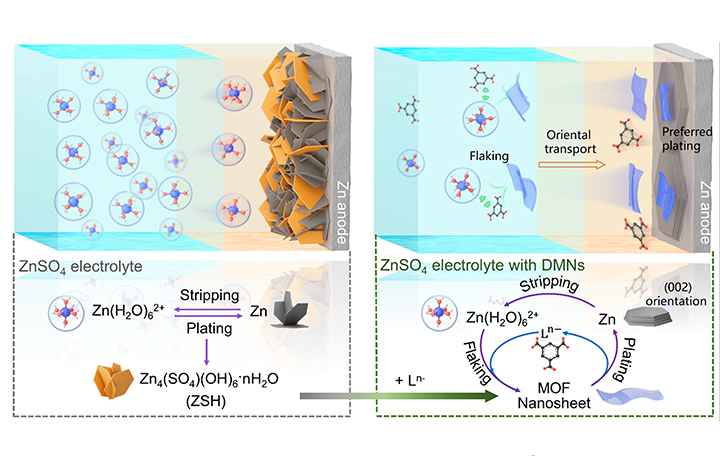 08 30, 2023Metal Organic Framework Nanosheets Employed as Ion Carriers for Self-Optimized Zinc AnodeResearchers imported macromolecular Zn2+ carriers with a large mass-to-charge ratio to decouple the ion flux from the inhomogeneous electric field and substrate. This strategy provided an efficient pathway to overcome the dendrite and side reaction problems.
08 30, 2023Metal Organic Framework Nanosheets Employed as Ion Carriers for Self-Optimized Zinc AnodeResearchers imported macromolecular Zn2+ carriers with a large mass-to-charge ratio to decouple the ion flux from the inhomogeneous electric field and substrate. This strategy provided an efficient pathway to overcome the dendrite and side reaction problems.
Aqueous rechargeable zinc ion batteries are promising in electric grid storage due to their low cost and intrinsic safety. However, the practical implementation is hindered by the poor reversibility of the zinc anode, primarily caused by the chaotic Zn deposition present as dendrite and side reactions.
Recently, a research group led by Prof. YANG Weishen and Dr. ZHU Kaiyue from the Dalian Institute of Chemical Physics (DICP) of the Chinese Academy of Sciences (CAS) has proposed a strategy of "ino carriers" by importing macromolecular Zn2+ carriers with a large mass-to-charge ratio to decouple the ion flux from the inhomogeneous electric field and substrate. This strategy provided an efficient pathway to overcome the dendrite and side reaction problems.
This study was published in Energy Environmental Science on August 18.
By harnessing dynamic MOF nanosheets, zinc anodes underwent a remarkable self-optimization process, resulting in the creation of a highly desirable surface with an unprecedented (002) orientation that is entirely free from any undesirable byproducts (Image by ZHU Kaiyue)
The researchers found that metal organic framework (MOF) nanosheets featuring migration capability under an electric field due to their one-dimensional (1D) channel structure and preferential Zn2+ adsorption, as well as unique reductive chemistry due to the weak coordination between ligands and zinc ions, enabling them to serve as dynamic Zn2+ ion carriers.
The dynamic MOF nanosheets could continually optimize zinc anode during cycling. Specifically, the zinc electrode was gradually reconstructed towards a horizontally aligned lamellae-like morphology and enhanced (002) texture, showing a relative texture coefficient of a 96.9 (maximum value of 100). This optimization on the morphology and texture could be attributed to the horizontal alignment of Zn2+ ions by the constraints of the MOF nanosheets.
Additionally, the presence of MOF ligands contributed to the elimination of undesirable Zn4SO4(OH)6·4H2O byproducts. These byproducts were spontaneously converted into useful MOF nanosheets through unique properties of ligands. Consequently, Zn||Zn symmetric cells and Zn||(NH4)2V10O25·8H2O full cells employing MOF nanosheets in electrolytes exhibited outstanding cycling performance at both low and high rates.
"The versatility of the 'ion carrier' holds promise for potential expansion into achieving highly reversible cycling in other rechargeable metal cells, owing to its broad applicability to various ligands, substrates and electrolytes," said Prof. YANG.
This work was supported by the National Natural Science Foundation of China and the Youth Innovation Fund of DICP. -
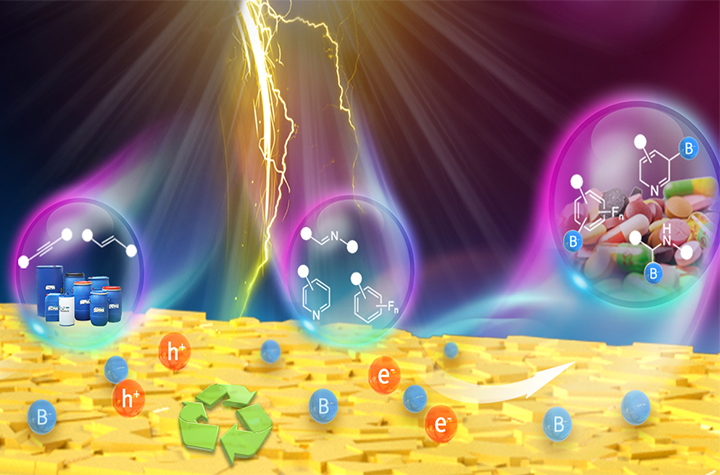 08 25, 2023Semiconductor Photocatalyst Helps to Realize Borylation ReactionResearchers achieved borylation reactions involving NHC-BH3), with a simple and efficient heterogeneous photocatalytic system, enabling a synthesis of high-value transformations, including hydroboration and boron substitution products.
08 25, 2023Semiconductor Photocatalyst Helps to Realize Borylation ReactionResearchers achieved borylation reactions involving NHC-BH3), with a simple and efficient heterogeneous photocatalytic system, enabling a synthesis of high-value transformations, including hydroboration and boron substitution products.
A research group led by Prof. DAI Wen from the Dalian Institute of Chemical Physics (DICP) of the Chinese Academy of Sciences (CAS) realized borylation reactions involving N-heterocyclic carbene boranes (NHC-BH3) with a simple and efficient heterogeneous photocatalytic system, enabling synthesis of high-value transformations including hydroboration and boron substitution products.
This study was published in Angewandte Chemie International Edition on Aug. 9, and it was selected as Hot Paper.
NHC-BH3 are novel boron sources in free radical borylation reactions due to their stable chemical properties and straightforward preparation method.
However, the application of NHC-BH3 is hindered by the requirement of a large quantity of harmful free radical initiators, as well as the expensive and non-recyclable homogeneous photocatalysts.
In this study, the researchers utilized cadmium sulfide nanosheets, which were easily prepared, as heterogeneous photocatalysts. And they served NHC-BH3 as a boron source, enabling the selective borylation reaction of various alkenes, alkynes, imines, aromatic (hetero) rings, and bioactive molecules under room temperature and light conditions. Since the conversion process fully utilized photogenerated electron-hole pairs, the need for sacrificial agents was eliminated.
Furthermore, they found that the photocatalytic system could not only achieve gram-scale scale-up, but also maintain a stable yield after multiple cycles of the catalyst. It could also serve as a recyclable general platform, allowing the recovered catalyst to continue catalyzing different kinds of substrates.
"Our study provide new ideas for the development of free radical borylation reactions using NHC-BH3 as a boron source, and the organoboranes obtained from the reaction may be used to synthesize synthetic building blocks that contain hydroxyl, borate, and difluoroborane reactive sites," said Prof. DAI.
The above work was supported by the Outstanding Youth Fund of Liaoning Province. -
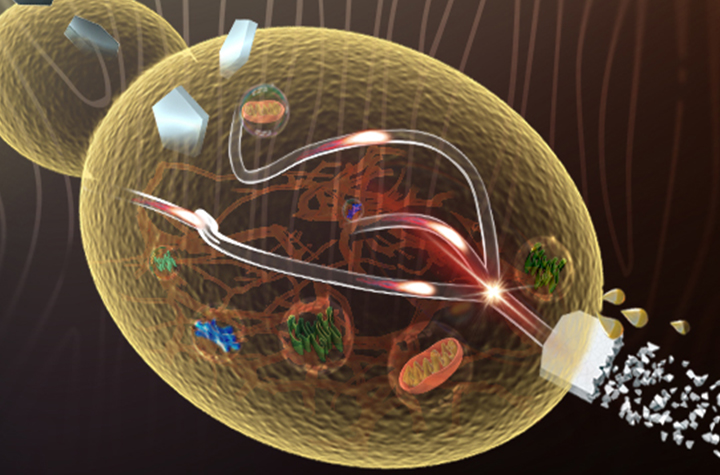 08 25, 2023Lignocellulose Bio-refinery Developed for Value-added Chemical Overproduction in YeastScientists has proposed a microbial platform for lignocellulose bio-refinery. It can efficiently synthesize acetyl-CoA derivatives, such as fatty acids (FFA) and 3-hydroxypropionic acid (3-HP), owing to the enhanced supply of precursor acetyl-CoA and cofactor NADPH by rewiring the cellular metabolism of Ogataea (Hansenula) polymorpha.
08 25, 2023Lignocellulose Bio-refinery Developed for Value-added Chemical Overproduction in YeastScientists has proposed a microbial platform for lignocellulose bio-refinery. It can efficiently synthesize acetyl-CoA derivatives, such as fatty acids (FFA) and 3-hydroxypropionic acid (3-HP), owing to the enhanced supply of precursor acetyl-CoA and cofactor NADPH by rewiring the cellular metabolism of Ogataea (Hansenula) polymorpha.
Lignocellulosic biomass is a renewable feedstock for 2nd-generation biomanufacturing. In particular, efficient co-fermentation of mixed glucose and xylose in lignocellulosic hydrolysates is a key issue in reducing product costs.
However, co-utilization of xylose and glucose in microbes is challenging due to limited xylose assimilation and the glucose repression effect.
Recently, a research group led by Prof. ZHOU Yongjin from the Dalian Institute of Chemical Physics (DICP) of the Chinese Academy of Sciences (CAS) has proposed a microbial platform for lignocellulose bio-refinery. It can efficiently synthesize acetyl-CoA derivatives, such as fatty acids (FFA) and 3-hydroxypropionic acid (3-HP), owing to the enhanced supply of precursor acetyl-CoA and cofactor NADPH by rewiring the cellular metabolism of Ogataea (Hansenula) polymorpha.
This study was published in Nature Chemical Biology on Aug. 24.
Fatty acids and 3-hydroxypropionic acid were efficiently produced by engineering co-utilization of glucose and xylose in Ogataea polymorpha for lignocellulose biorefinery (Image by ZHOU Yongjin)
The researchers realized co-utilization of glucose and xylose by introducing a hexose transporter mutant and xylose isomerase, and overexpressing the native xylulokinase to enhance xylose catabolism and import.
The engineered strain produced 7.0 g/L FFA from real lignocellulosic hydrolysates in shake flasks and 38.2 g/L FFA from simulated lignocellulose in a bioreactor. Furthermore, this superior cell factory was expanded for 3-HP production by a metabolic transforming strategy, obtaining the highest 3-HP titer of 79.6 g/L from simulated lignocellulose.
"Our work realized co-utilization of xylose and glucose without compromising native glucose metabolism and demonstrated the potential of O. polymorpha as a cell factory to produce versatile value-added chemicals from lignocellulose," said Prof. ZHOU. -
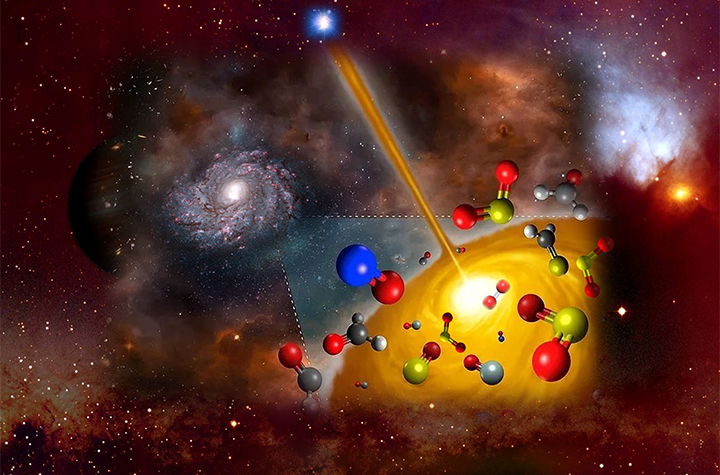 08 18, 2023Oxygen Production from Volcanic Sulfur Dioxide Photochemistry: A Possible Trigger for the Earth's Great Oxidation EventResearchers revealed oxygen production from vacuum ultraviolet photodissociation of sulfur dioxide using the Dalian Coherent Light Source.The provenance of oxygen (O2) has been linked to the early Earth's atmospheric and biological evolution. A permanent rise to appreciable concentrations of O2 in the atmosphere, known as the "Great Oxidation Event (GOE)", was estimated to have occurred at around 2.4 billion years ago. However, the cause of the GOE still remains unclear.Besides the biogenic processes leading to O2 production, the widely accepted abiotic O2 production is through photolysis of carbon dioxide (CO2) and water molecule (HO2).Now, a research group led by Prof. YUAN Kaijun and YANG Xueming from the Dalian Institute of Chemical Physics (DICP) of the Chinese Academy of Sciences has reported oxygen production from vacuum ultraviolet photodissociation of sulfur dioxide (SO2) using the Dalian Coherent Light Source.Their findings were published in Chemical Science on Aug. 1. The article was chosen as a Hot Article.Dalian Coherent Light Source revealing vacuum ultraviolet photodissociation of sulfur dioxide as an important prebiotic-O2 source (Image by YUAN Kaijun)"Our experimental results revealed a direct dissociation channel yielding S(1D) + O2 products from vacuum ultraviolet (VUV) photodissociation of SO2 in the wavelength range between 120 and 160 nm," said Prof. YUAN.Geological evidences have identified the strong activity of SO2 photochemistry during the Earth's late Archaean eon, which linked to the origin of the sulfur mass independent fractionation in ancient rocks. But its role in the formation of molecular oxygen is ignored.The quantitative determination demonstrated that O2 production was an important channel from SO2 VUV photodissociation, with a branching ratio of around 30% at the H Lyman-a wavelength (121.6 nm).The relatively large amounts of SO2 emitted from volcanic eruptions in the Earth's late Archaean eon imply that VUV photodissociation of SO2 could have provided a crucial additional source term in the O2 budget in Earth's primitive atmosphere. Therefore, this event may lead to transient O2 accumulation and could be one possible cause of the GOE.This research was supported by the Chemical Dynamics Research Center, and the National Natural Science Foundation of China.
08 18, 2023Oxygen Production from Volcanic Sulfur Dioxide Photochemistry: A Possible Trigger for the Earth's Great Oxidation EventResearchers revealed oxygen production from vacuum ultraviolet photodissociation of sulfur dioxide using the Dalian Coherent Light Source.The provenance of oxygen (O2) has been linked to the early Earth's atmospheric and biological evolution. A permanent rise to appreciable concentrations of O2 in the atmosphere, known as the "Great Oxidation Event (GOE)", was estimated to have occurred at around 2.4 billion years ago. However, the cause of the GOE still remains unclear.Besides the biogenic processes leading to O2 production, the widely accepted abiotic O2 production is through photolysis of carbon dioxide (CO2) and water molecule (HO2).Now, a research group led by Prof. YUAN Kaijun and YANG Xueming from the Dalian Institute of Chemical Physics (DICP) of the Chinese Academy of Sciences has reported oxygen production from vacuum ultraviolet photodissociation of sulfur dioxide (SO2) using the Dalian Coherent Light Source.Their findings were published in Chemical Science on Aug. 1. The article was chosen as a Hot Article.Dalian Coherent Light Source revealing vacuum ultraviolet photodissociation of sulfur dioxide as an important prebiotic-O2 source (Image by YUAN Kaijun)"Our experimental results revealed a direct dissociation channel yielding S(1D) + O2 products from vacuum ultraviolet (VUV) photodissociation of SO2 in the wavelength range between 120 and 160 nm," said Prof. YUAN.Geological evidences have identified the strong activity of SO2 photochemistry during the Earth's late Archaean eon, which linked to the origin of the sulfur mass independent fractionation in ancient rocks. But its role in the formation of molecular oxygen is ignored.The quantitative determination demonstrated that O2 production was an important channel from SO2 VUV photodissociation, with a branching ratio of around 30% at the H Lyman-a wavelength (121.6 nm).The relatively large amounts of SO2 emitted from volcanic eruptions in the Earth's late Archaean eon imply that VUV photodissociation of SO2 could have provided a crucial additional source term in the O2 budget in Earth's primitive atmosphere. Therefore, this event may lead to transient O2 accumulation and could be one possible cause of the GOE.This research was supported by the Chemical Dynamics Research Center, and the National Natural Science Foundation of China. -
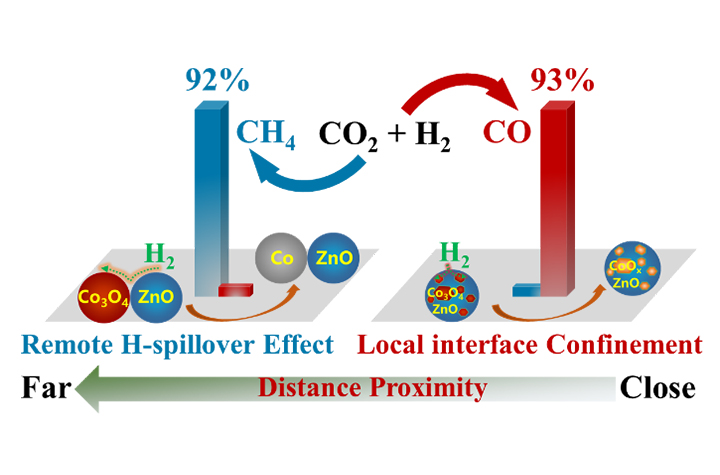 08 02, 2023Researchers Disentangle Local Interfacial Confinement and Remote Spillover Effects in Oxide-Oxide InteractionResearchers disentangled local interfacial confinement and remote spillover effects in oxide-oxide interaction.
08 02, 2023Researchers Disentangle Local Interfacial Confinement and Remote Spillover Effects in Oxide-Oxide InteractionResearchers disentangled local interfacial confinement and remote spillover effects in oxide-oxide interaction.
Supported oxides are widely used in many important catalytic reactions, in which the interaction between oxide catalyst and oxide support is critical but still remains elusive.
Recently, a research team led by Prof. BAO Xinhe and Prof. FU Qiang from the Dalian Institute of Chemical Physics (DICP) of the Chinese Academy of Sciences (CAS) disentangled local interfacial confinement and remote spillover effects in oxide-oxide interaction.
This work was published in the Journal of the American Chemical Society on July 26.
Schematic depiction of the effect of remote H spillover and local interfacial bonding on CO2 hydrogenation in oxide-oxides catalysts (Image by DONG Cui)
The researchers constructed a chemically bonded oxide-oxide interface by chemical deposition of Co3O4 onto ZnO powder (Co3O4/ZnO), in which complete reduction of Co3O4 to Co0 had been strongly impeded. They revealed that the local interfacial confinement effect between Co oxide and ZnO support helped to maintain a metastable CoOx state (mainly CoO) in CO2 hydrogenation reaction, producing 93% CO. In contrast, a physically contacted oxide-oxide interface was formed by mechanically mixing Co3O4 and ZnO powders (Co3O4-ZnO), in which reduction of Co3O4 to Co0 was promoted, demonstrating a quick increase of CO2 conversion to 45% and a high selectivity towards CH4 (92%) in the CO2 hydrogenation reaction. This interface effect was ascribed to unusual remote spillover of dissociated hydrogen species from ZnO nanoparticles to the neighboring Co oxide nanoparticles.
"Our study illustrates the equally important but opposite local and remote effects at the oxide-oxide interfaces, and the distinct oxide-oxide interactions contribute to many diverse interface phenomena in oxide-oxide catalytic systems," said Prof. FU.
This work was supported by the National Key R&D Program of China, the National Natural Science Foundation of China, and the Photon Science Center for Carbon Neutrality. -
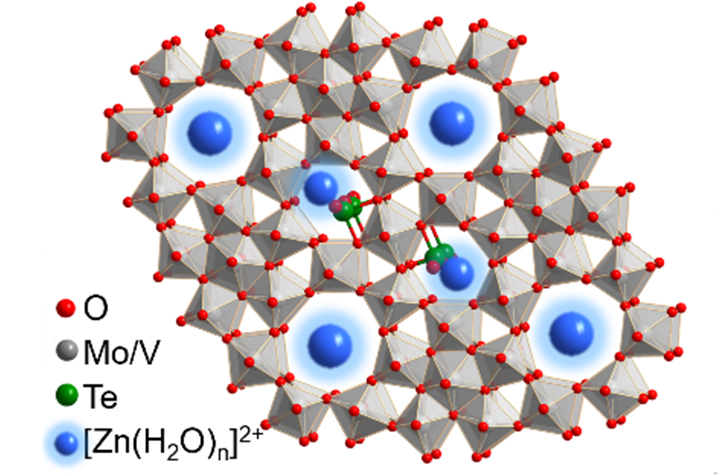 08 01, 2023Researchers Conduct Atomic Scale Analysis of Zn2+ Storage in Robust Tunnel FrameworksResearchers presented the novel application of MoVTe oxide with an M1 phase (MVT-M1) as potential cathode materials for ZIBs and conducted atomic scale analysis of Zn2+ storage process in MVT-M1.
08 01, 2023Researchers Conduct Atomic Scale Analysis of Zn2+ Storage in Robust Tunnel FrameworksResearchers presented the novel application of MoVTe oxide with an M1 phase (MVT-M1) as potential cathode materials for ZIBs and conducted atomic scale analysis of Zn2+ storage process in MVT-M1.
Zinc-ion batteries (ZIBs) based on near-neutral aqueous electrolytes represent a promising large-scale energy storage solution for deeper and broader penetration of clean renewable energy because of their outstanding merits in energy density, cost, and eco-friendliness.
Realizing rapid and reversible Zn2+ storage at the cathode is imperative for the advancement of aqueous ZIBs, which offer an option for large-scale electrochemical energy storage. However, owing to limitations of the structural stability of previously investigated frameworks, the Zn2+ storage processes remain unclear.
Recently, a research group led by Prof. YANG Weishen and Dr. ZHU Kaiyue from the Dalian Institute of Chemical Physics (DICP) of the Chinese Academy of Sciences (CAS) presented the novel application of MoVTe oxide with an M1 phase (MVT-M1) as potential cathode materials for ZIBs and conducted atomic scale analysis of Zn2+ storage process in MVT-M1.
This study was published in Chemical Science on July 27.
MoVTe oxide with M1 phase for storing Zn2+ (Image by ZHU Kaiyue)
The researchers found that MVT-M1 featured broad and robust tunnels that facilitated reversible Zn2+ insertion/extraction during cycling, as well as rich redox centers (Mo, V, and Te) to aid in charge redistribution, resulting in good performances in ZIBs.
Due to the exceptional resilience of MVT-M1 to high-energy electron beams, they directly observed Zn2+ insertion/extraction at the atomic scale within the tunnels using high-angle annular dark field scanning transmission electron microscopy. Moreover, they determined the storage location of zinc ions within the cathode layer by layer from the surface to the bulk phase by employing time-of-flight secondary ion mass spectrometry. Additionally, solvent molecules, including H2O and methanol, were also found inside the tunnels along with Zn2+.
"Our results are helpful to understand the Zn2+ storage mechanism and enable the design of novel materials specifically optimized for efficient Zn2+ storage," said Prof. YANG.
The above work was supported by the National Natural Science Foundation of China and the Youth Innovation Fund of DICP.